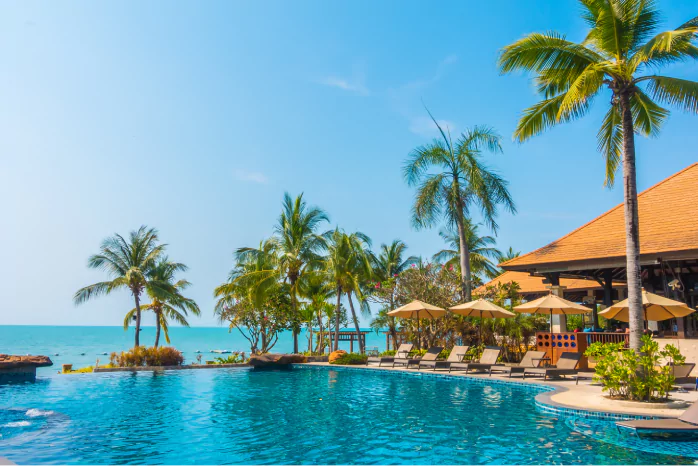Goa is India’s smallest state in terms of area, but distinguished by pristine beaches, a vibrant culture, and a charming Portuguese heritage where East meets West. Goa occupies considerable space in the Indian tourism, economic, and historical contexts considering its tiny presence on the India
Goa General Knowledge encompasses a wide variety of facts related to this small but impactful state on India’s western coast, including history, geography, culture, and tourism.
1. Goa General Knowledge
Key Information
State Name: Goa
Capital: Panaji
Largest City: Vasco da Gama
Official Language: Konkani
Other Languages Spoken: Marathi, English, Hindi, Portuguese (historically)
Total Area: 3,702 sq km
Population: Approx. 1.5 million (as per 2021 estimates)
Formation of the State: 30 May 1987 (State and formerly a Union Territory)
Animal of the State: Gaur-Indian Bison
Bird of the State: Flame-throated Bulbul
Tree of the State: Matti-Terminalia crenulata
2. Geography
Goa is one of the smallest states in India. Located on the western coast it borders Maharashtra State at the northern direction and, at the eastern and southern directions, it borders Karnataka State and shares the Arabian Sea to its west. But the geography of this small land is full of beaches, forests, rivers, and much more.
Coast: 160 km of coastline on the Arabian Sea
Major Rivers : Mandovi, Zuari, Chapora, Sal, and Terekhol
Beaches: Some of the most famous beaches in India are Calangute, Baga, Anjuna, Colva, Palolem, and Vagator.
Wildlife Sanctuaries: Bhagwan Mahavir Wildlife Sanctuary, Cotigao Wildlife Sanctuary, and Salim Ali Bird Sanctuary.
3. History of Goa
Pre-Portuguese Period: Goa has its history dating back to the Mauryan and Satavahana periods, besides other kingdoms. The region was under successive dynasties of Kadambas, Chalukyas, and Yadavas.
Portuguese Regime: The Portuguese conquest of Goa started in the year 1510 by Afonso de Albuquerque. The region served as a Portuguese colony for more than 450 years longer than any other region in India.
Liberation of Goa: Goa was freed from the Portuguese by the Indian Armed Forces on 19 December 1961, an operation known as Operation Vijay. It later became a Union Territory and finally, in 30 May 1987, Goa attained its status as the 25th state of India.
4. Culture
Festivals:
- Goa Carnival: The great Goan carnival that occurs before Lent is one of the prime festive traditions of Goa.
- Feast of St. Francis Xavier : The Feast held every year in the Basilica of Bom Jesus, Old Goa is a feast that attracts pilgrims from all over the world.
- Shigmo: It is a spring festival, the people of Hindu religion celebrate in Goa.
Goa has a rich tradition of both Western and Indian music. Swaying to the swings of Western classicals, one can hardly forget the euphoric influence of the Portuguese in Goan culture. Goan folk dance forms include Dekhni and Fugdi.
Cuisine: Goa is a culinary blend of Portuguese and Indian delights. The foremost dishes include Goan Fish Curry, Prawn Balchao, and Vindaloo. Coconut, fish, rice, and spices form significant ingredients.
5. Districts of Goa
Goa has only two districts
North Goa:
- Capital: Panaji
- Important Towns: Panaji, Mapusa, Bicholim, Ponda
- Famous Tourist Places: Baga Beach, Calangute Beach, Aguada Fort, Old Goa
South Goa:
- Capital: Margao
- Important Towns: Margao, Vasco da Gama, Canacona, Quepem
- Tourist Places: Colva Beach, Palolem Beach, Dudhsagar Falls, Cabo de Rama
6. Economy
Goa’s economy majorly thrives on tourism, agriculture, and mining:
Tourism: Goa is one among the most visited places by tourists in India. Millions of tourists come each year to its beaches, fireworks, and cultural heritage.
Mining: Goa is ample in minerals such as iron ore, manganese and bauxite. Mining operations have recently been restricted mainly because of environmental factors.
Agriculture: Main agricultural products of Goa are rice, coconut, cashew, and areca nut.
Fisheries: Due to long coastline, fishing is one of the major economic activities for several people in Goa.
7. Famous Personalities from Goa
Manohar Parrikar: Former Chief Minister of Goa and Defence Minister of India.
Lata Mangeshkar: One of the most legendary playback singers from India, belonging to a Goan family .
Remo Fernandes: A famous Goan singer who fused the sounds of Western music with Indian vibes.
Mario Miranda: This cartoonist and painter is well-known from Goa for his humorous graphics.
8. Tourist Spots in Goa
Basilica of Bom Jesus: This is one of the UNESCO World Heritage sites located in Old Goa, which holds the mortal remains of St. Francis Xavier.
Se Cathedral: It is one of the biggest churches in Asia, and this place lies in Old Goa.
Aguada Fort: This is the well-maintained Portuguese fort of 17th Century, located along with the excellent view of the Arabian Sea.
Dudhsagar Falls: It is a conspicuous waterfall on the Goa-Karnataka border, one of the India’s tallest waterfalls.
Chapora Fort: The very famous movie Dil Chahta Hai has shot here, offering a panoramic view of the coast.
9. Trivia & Fun Facts
Longest Portuguese Rule: Goa was under the Portuguese rule for 451 years, that is the longest any place in India ever is.
Smallest State: Goa is the smallest state of India by area but the most developed and prosperous region.
Goa Carnival: The Portuguese introduced the Carnival to Goa, and people celebrate it with great enthusiasm. It is only celebrated here in Goa in India.
For More Information Visit : – India gk
Contact for website Design and development – Chaturbhuja Sons

